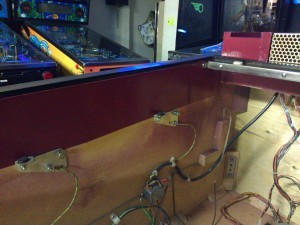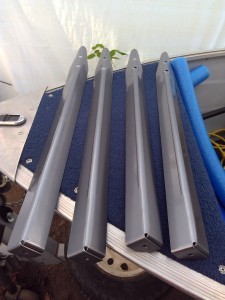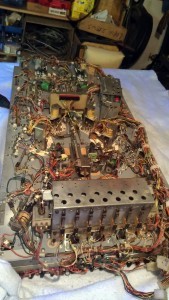Restoring a Bally Medusa
I’ve talked about electronic maintenance on our pinball machines before, including some fairly serious refurbishing. One type of restoration my father and I were hesitant to try was cosmetic, since we aren’t exactly artistic.
Well, we did it anyway! Read on for a full, detailed account of our journey restoring a Bally Medusa.
Paint is always a tricky thing to work with. I’ve learnt this first hand painting my car. The important thing is to always take your time, and to control the coats you put on. It is easy to want to lay a thick coat right away, but too thick and you are back at square one.
Most older pinball machines used oil paint and stencils. First a base colour coat is applied, which is your background colour. Next, one or more stencils are applied, and different coloured layers are sprayed.
Stencils are being reproduced these days for some pinball machines. We found a kit for Medusa for around $180. It is quite expensive, but the material of the stencil is designed to absorb around the edges to prevent the paint from bleeding.
Why Medusa?
When we buy a new machines, we don’t mind if the electronics isn’t 100%, we can fix that. But ideally, we aim for something with a good playfield, and a decent cabinet, artistic things that aren’t so easily corrected. Medusa had a very nice playfield and backglass, with only the cabinet fading.
One thing we needed to repair before painting was the backboard of the bottom cabinet. It is a piece of MDF, basically super-fine sawdust and glue. It had swelled a bit from moisture, and chipped at the edges. As well, the backbox mount was not as solid as we would like, so we needed to reinforce it.
1. Repairing the body
Removal of the old rear panel required little more than a screw driver to pry, a jigsaw to cut down the middle, and a sledgehammer to break it out.
A brand new piece of plywood was installed, and everything was sanded and made pretty with bondo.
2. Preparing for paint
Everything must go! The playfield was removed, as well as everything inside the cabinet: power supply, coin door, flipper buttons, side rails, and plunger. Next, the whole body needs sanding, then masking.
For the backbox, we removed the door, and all the circuit boards. The trick will be routing all the cables when we put it back together!
3. Primer
We decided to use water-based paints, rather than oil. Although oil lasts longer, it also smells strongly for months. We can’t have that in our garage, and we don’t want it to stink at the Ottawa Pinball Expo.
So that the paint’s colour would show best, we used a pink-tinted primer. The primer and paint layers were applied using a Lemmer L300 electric spray gun.
The rear of the backbox is also MDF, and absorbed a lot of paint.
4. Paint
Once primed, the pinball machine is ready for paint. In order to select the base colour, we had a little problem. The original cabinet was so faded, and we would not be able to use it to get a colour match. So, we found something else to match:
The playfield skirt was still basically the same colour as the original. So, we took off the skirt, brought it to the hardware store, and they got the colour just right.

We did two coats of paint, sanding in between. The first coat was slightly too thick, but the wood absorbed a lot of it. Our first coat used a full pint of paint. Make sure you buy enough!
5. Stencils
The final coat of paints needs to be very dry before applying the stencils. We let the machine bake in the sun for over a week. Before applying the stencils, we gave it a light sanding.
Applying the stencils was very challenging. The stencil itself is not very adhesive, and has a tendency to lift easily. The protective transparent layer above the stencil, however, is very adhesive, and it takes time and patience to completely transfer the stencil.
The right side went on without issue. However, the left side was much more problematic.
In the above photo, you can see that whoever designed these stencils didn’t check to see if what he was doing was right. The “Bally” logo is mirrored on the left side – in fact, the left stencil is simply a mirror of the right side, and doesn’t account for the fact that text is also backwards.
To fix this, we cut the logo from the left stencil, and did it separately, using some of the extra stencil paper to transcribe the logo correctly.
After masking everything not to be painted, we were ready to spray the gold paint for the artwork. The paint used has a metallic appearance, but isn’t a super flashy gold. I think it looks very good:
We thought applying the stencil to the backbox was hard. Imagine how worried we were to do the whole cabinet, which had giant, 4 foot long stencils.
My dad and his girlfriend applied these stencils sometime after midnight, and developed quite the technique, unrolling the protective layer and evening out the stencil. The next morning, my dad painted it all.
6. Clear coat
After putting this much work into painting the cabinet, we wanted to protect it as much as possible for inevitable bumps and dings. This called for some Varathane clear coat.
The outside of the machine received 5 layers of clear coat. We bought a special Varathane paintbrush, with soft tips, hoping that it would result in an even coat, however it actually seemed to streak! In the end, we used cheap sponge brushes, and without much trouble we had a smooth finish.
On the inside, where the playfield tends to wear the paint from being lifted up and down, we applied 7 coats.
7. Finishing Touches
Since we had everything taken apart, before reassembly we made sure to clean and restore all the trim pieces and little parts.
The legs were painted with the same type of paint as the stenciling, only silver. They look very sharp.
We also painted the front grille. It was originally a dark-grey/black, but it looks good in gold, too. Note the new felts on the playfield glass support.
While we had the playfield out, we took the opportunity to clean out all the light inserts, all the switches, and repair some that were beyond cleaning.
To clean the switches, we do not follow the standard method. While almost all literature strictly instructs to place a business card between the contacts, press them together, and pull it out, we find it to be often ineffective.
This is super-effective. The brass pencil tip for a rotary tool removes all carbon build up on the switch contacts. The business card trick is recommended because it doesn’t risk wearing out the contacts. The brass brush might wear them a little, however the resulting clean is remarkable.
Wow.
8. Rewire, reassemble
Remember how I mentioned that routing the wires would be the tricky part? That was no overstatement.
Wires come from the backbox door for the displays and lights, they come from the playfield and the power supply, and they run all around from board to board.
The side rails were installed with new nails, and everything else got pieced together.
New nylon feet were used to replace the old, rusty feet on the rear panel. This is also more friendly for carpets.
Concluding thoughts
This was a lot of work. It took around a month to do. There are a lot of opportunities to make mistakes, as well. When we started this, we figured we would only do this once, just to say that we did, and to have a really, really nice Medusa. Now, we’re thinking this might not be the only one, though it will be a while until the next.
 Seven layers of Varathane to protect the inside of the cab.
Seven layers of Varathane to protect the inside of the cab.
We are very happy with the end result, and can’t wait to bring it to the Ottawa Pinball Expo to show off a sharp machine.












































Dan,
Nice to read about your restoration of your Medusa. I am from Sydney, Australia and am currently on holidays in Ottawa. I attended the pinball show today and played your machine. Such a nicely restored machine and great to play. In my opinion probably the nicest machine at the show. There is a Medusa that I might be able to purchase sometime soon so it was great to have a game on yours. I am sure you will get more great comments about your machiine.
Kind regards,
James Grimes
James,
Thank you very much for your kind words. I am very glad you added the expo to your list of activities while in Ottawa, and am more than pleased to have had you enjoy our Medusa. I am pleasantly surprised that you found my site so quickly, but it shows me that maintaining it is worth all the effort.
Take care,
Dan
Hi Dan, Beautiful job! I just uncovered one of these same machines in my basement. I tried to power it up but no luck. No power at all. Maybe I will look more into it.
Sincerely,
Pattie
Medusa is a gem of a machine, I wish you the best in getting yours back into playing condition. Nothing is more tragic than a machine wasting away!
Thank you Dan. I know it did work at one time. Once again, beautiful job on restoring yours!